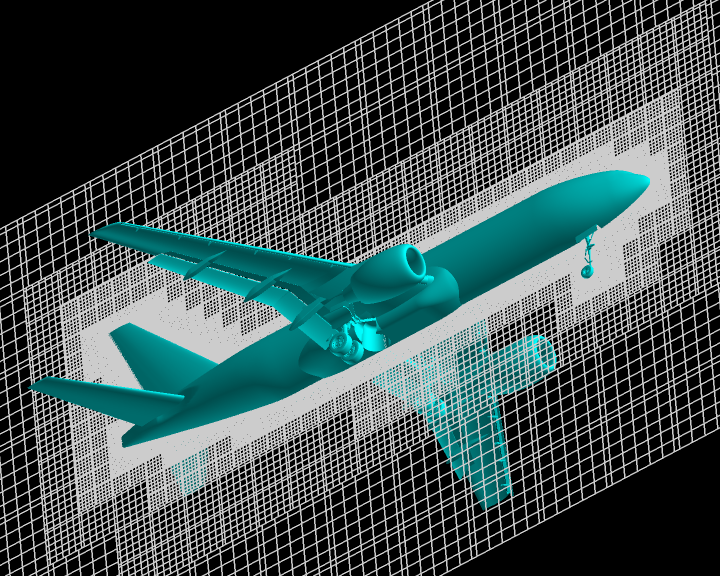Post-K Priority Issue 8D: Research and development of core technology to innovate aircraft design and operation
JAXA Supercomputer System Annual Report April 2018-March 2019
Report Number: R18ECMP06
Subject Category: Competitive Funding
- Responsible Representative: Yuko Inatomi, Institute of Space and Astronautical Science, Department of Interdisciplinary Space Science
- Contact Information: Ryoji Takaki(ryo@isas.jaxa.jp)
- Members: Ryoji Takaki, Taku Nonomura, Seiji Tsutsumi, Yuma Fukushima, Soshi Kawai, Ikuo Miyoshi, Satoshi Sekimoto, Hiroshi Koizumi, Tomohide Inari, Ryota Hirashima, Yoshiharu Tamaki, Takuya Karatsu
Abstract
We develop a high-speed/high-precision computational program using a quasi-first principle method, which can faithfully reproduce the actual flight environment to understand the true nature of fluid phenomena. Specifically, we develop a high-precision compressible flow solver with geometric wall models and LES (Large Eddy Simulation) wall models based on hierarchical, orthogonal and equally spaced structured grids.
Reference URL
Please refer to ‘サブ課題D|重点課題8:近未来型ものづくりを先導する革新的設計・製造プロセスの開発‘.
Reasons for using JSS2
We need large computer like JSS2 because our calculations must be large scale computations. Moreover, JSS2 has a similar architecture to the our target computer called Post-K.
Achievements of the Year
We proceeded with the development of a compressible fluid analysis program FFVHC – ACE using a hierarchical, orthogonal and equally spaced structured grid method. In this fiscal year, a trial calculation for the aircraft of the actual detailed shape (JSM_CRM_LEG model) was performed using the immersed boundary method . Figure 1 is the computational grid for the JSM_CRM_LEG model. Figure 2 shows the object surface of the landing gear expressed in the flow solver. The reproducibility of the object surface is improved as the grid resolution improves. Figure 3 shows the vorticity around the JSM_CRM_LEG model, where Mach number is 0.2, the Reynolds number is 10 6 , and attack angle is 7 degrees. The total number of grid points is about 800 million, of which the number of fluid points is about 600 million.

Fig.1: The hierarchical, orthogonal and equally spaced structured grid around the JSM_CRM_LEG model.
Fig.3(video): Flow around the JSM_CRM_LEG model.
Publications
– Oral Presentations
R. Takaki, Toward the achievement of the aerodynamic characteristic evaluation for real configurations and real flight environments of aircraft, 4rd Symposium on Post-K computer Priority Issue 8.
– Other
Ryoji Takaki, How to make an aerospace vehicle with supercomputer !? – Roles of supercomputer in manufacturing – , 13th symposium to know K-computer in Mito – From K-computer to Post-K computer.
Usage of JSS2
Computational Information
- Process Parallelization Methods: MPI
- Thread Parallelization Methods: OpenMP
- Number of Processes: 256 – 600
- Elapsed Time per Case: 120 Hour(s)
Resources Used
Fraction of Usage in Total Resources*1(%): 3.88
Details
Please refer to System Configuration of JSS2 for the system configuration and major specifications of JSS2.
| System Name | Amount of Core Time(core x hours) | Fraction of Usage*2(%) |
|---|---|---|
| SORA-MA | 36,154,361.50 | 4.43 |
| SORA-PP | 6,470.46 | 0.05 |
| SORA-LM | 0.00 | 0.00 |
| SORA-TPP | 0.00 | 0.00 |
| File System Name | Storage Assigned(GiB) | Fraction of Usage*2(%) |
|---|---|---|
| /home | 2,181.51 | 2.26 |
| /data | 33,258.50 | 0.59 |
| /ltmp | 12,472.17 | 1.07 |
| Archiver Name | Storage Used(TiB) | Fraction of Usage*2(%) |
|---|---|---|
| J-SPACE | 36.60 | 1.28 |
*1: Fraction of Usage in Total Resources: Weighted average of three resource types (Computing, File System, and Archiver).
*2: Fraction of Usage:Percentage of usage relative to each resource used in one year.
JAXA Supercomputer System Annual Report April 2018-March 2019



